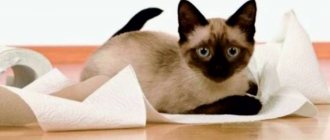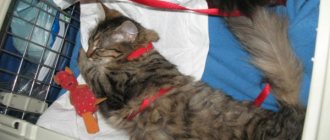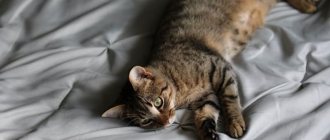Sometimes, due to psychological or physical discomfort, a pet stops defecating in the litter box. A person’s screams or poking his muzzle into the tray are ineffective in this case, but the attentive attitude of the owner will help correct the situation as soon as possible - this will be discussed in the article.
Representatives of felines are classified as affectionate, clean animals, for this reason many owners are happy to have a cat. Each pet has its own character. The owner will need a little time to help the animal form the right habits. The most crucial moment is to teach the cat to go to the litter box. If you do not do this on time, then in the near future a problem will arise, how to wean a cat from shitting in the wrong place.
Why do they do this
In order to stop your pet from shitting anywhere, you need, first of all, to understand what prompts him to such behavior. Cats are extremely clean animals. If they go to the toilet anywhere except their litter box, then there are good reasons for this. Which ones exactly?
- Reason 1 – emotional state. Animals, like their owners, experience a variety of emotions: joy and sadness, fun and indignation. They try to express their condition with their voice, gaze, touch, but most of us cannot (and often do not strive) to understand what is bothering our pet. What remains for the poor animal but to resort to the most accessible method of explanation for its slow-witted owners?
- Reason 2 – lack of attention. Automata, no matter how perfect they are, cannot replace animal communication with humans. Is it possible to love an automatic feeder, talk to an automatic waterer, or expect that the most expensive play complex, the size of half a room, will take you in its arms and begin to stroke you, saying something quietly? Of course no. Left to its own devices all day, the cat suffers from loneliness. To attract the attention of the owner and make him feel how bad she is, the cat chooses a very unique method: shitting in the wrong places. If you find a very dubious sign of attention in your slippers or on the bed, do not rush to scold the animal. It is quite possible that in this way he is trying to attract your attention, to achieve affection and love.
- Reason 3 – fear and stress. A too small kitten, left without a mother, is in a state of severe stress. Unfamiliar surroundings, unusual smells and sounds, unknown people - how can you not be scared? Don't forget about changing your diet. Many kids, having tasted unfamiliar food that is too fatty for their tiny stomachs, react to it in exactly this way - by heartily shitting on the floor.
- Reason 4 – I don’t like the tray or the place in which it is located. In most cases, cats quickly adapt to any litter box configuration. But sometimes it is purely physically uncomfortable for an animal to climb into it and jump out. It may be difficult for a small kitten to climb over a side that is too high for him or he simply does not have time to do it. Some people don’t like the grate in the tray, while others, on the contrary, can’t imagine how they can go to the toilet without it. The place where the tray is placed is also of great importance. If your kitty stubbornly goes to the toilet in a secluded corner, you should not try to re-educate her by forcing her to use the litter tray located almost in the center of the living room. Place the tray where she used her toilet. She will willingly go to it.
- Reason 5 – the filler is unpleasant. Even if your pet descends from his great-grandfather Alexander the Great, it is by no means a fact that he will deign to pay his attention to a tray with expensive modern filler. Perhaps his royal paws find it more pleasant to dig into sawdust or quarry sand. We should not forget that we ourselves sometimes have a strange tactile taste, preferring the rough surface of jute burlap to the most delicate silk.
- Reason 6 – lack of knowledge. If you receive a newborn orphan kitten, you should not be surprised that he does not understand what the tray is for. No one explained this to him! Now it is yours, and only your task. Show patience and all the teaching talent you can muster. Soon your little pet will become a rare clean person.
- Reason 7 – health problems. If an always neat cat suddenly begins to walk past the litter box or even choose inappropriate places for this purpose, we advise you to show him to the veterinarian as soon as possible. This could be a sign of serious health problems. This is often done by very old animals that have developed mental problems.
Careful observation of your pet will help you determine the reason that prompts him to use any suitable corner of the apartment as a toilet. From now on, your task is to do everything possible to direct the animal “on the right path.”
This is interesting: What to do if your cat has a bone stuck in its throat?
What aerosols are best to use for repelling?
When folk remedies don’t help and the owners are completely desperate, aerosols and special chemicals can come to the rescue that can scare away both an adult cat that is shitting and a kitten that cannot remember the location of the potty.
There are two main types of sprays which are:
- scare away cats;
- attract cats.
You can choose your own litter box training tactics. It all depends on whether you want to attract the cat with a smell to the place where he should directly do his business, or whether you want to discourage him from all his “favorite” places and simply leave him no choice.
The cost of such toilet training products is quite reasonable.
When a pet categorically refuses to go to the toilet and at the same time spoils property and things, the owner can often reach a state of despair.
However, you should not rush to conclusions and think that your cat is doing his dirty tricks to spite you. It is quite possible that a specific reason led to this behavior, which must be identified.
Why does a cat shit in the wrong place: reasons
Before taking any action, you need to find out why the cat began to shit anywhere. Let's look at several common reasons why a cat shits in the wrong place:
Physical discomfort.
- With inflammatory processes in the genitourinary system, cats experience discomfort when defecating. Repeated repetition of the problem creates a negative attitude towards the litter box.
- The pet begins to look for new places to defecate, causing a lot of trouble for its owner. In some situations, this cat behavior can be regarded as a signal for help.
Finding a solution
Psychological discomfort.
- If a cat began to shit during a period of dramatic changes in the personal life of the owners, then this behavior, when the kitten shits in the wrong place, is associated with the psychological discomfort of the animal.
- Cats sense the situation in the house well and get used to the usual way of life of their owner. Home renovations, the arrival of a new family member or other living creature, cause stress in the animal, which affects its behavior.
Lack of attention.
- Like any pet, cats require attention. If the owners are ruthless towards the animal, then characteristic cats change their behavior. They are capable of holding grudges and doing mischief in order to attract attention.
- The simplest thing is to start shitting in the wrong place. The owner obviously won't like this.
It is important to eliminate psychological discomfort
New location of the cat litter.
- If your pet is used to going to defecate in a specific place, then changing the position of the toilet causes him stress. If you want to rearrange the furniture, it is better not to move the animal's tray. Buying a new litter box or changing the brand of litter also often causes a negative reaction from the animal - the cat shits in the wrong place.
- When moving to a new apartment, the cat needs to get used to the new territory. Owners must be patient and help their pet, including weaning the cat from shitting in the wrong place.
How to use repellent odors at home?
It’s not enough to know what smell cats can’t stand. You need to check if your pet is allergic to it. You need to treat the surface with a small amount of the drug and observe the pet’s reaction. A slight increase in salivation and lacrimation is allowed, which disappears as soon as it leaves the area of action of the smell.
Surface treatment rules:
- Cleaning the premises. It is necessary to remove traces and the smell of the cat’s vital activity from the marked areas so that the pet no longer associates them as places for the discharge of natural needs. Detergents with alcohol, homemade solutions with citric acid, soda and potassium permanganate remove odors well. After cleaning, the room must be ventilated.
- Application of a substance with a repellent odor. You need to wipe the surface with a solution of essential oils, herbal decoction, etc., and then place pieces of cotton wool soaked in the same substances near it. It is necessary to periodically change the cotton wool, as the smell gradually disappears. It is necessary to treat only those areas that the cat has chosen, because a pet that is followed by an unpleasant odor everywhere becomes restless and irritable.
Next, you need to observe the cat’s behavior - this will allow you to determine why he is marking his territory. If, after the ban, he began to relieve himself in the owner’s favorite chair, the matter is most likely a desire to maintain his authority or resentment.
Possible causes of toilet problems
First of all, in order to discourage a cat from pooping, you need to find out the reason for the changes in behavior. These may be the following reasons:
- illness;
- stress and other psychological problems;
- I don’t like the tray, litter or location of the toilet.
If a kitten appears in the house, we advise you to immediately find out from the previous owners whether he is accustomed to the litter box and what type of litter. If the kitten is taken from the street, then you will have to train the fluffy. To do this, it is necessary to “plant” the kitten in the tray after waking up and almost immediately after eating. For the successful completion of the task, the animal must be praised and caressed.
© shutterstock
Expert advice
Experienced felinologists offer several effective tips on litter training cats. Take advantage of some of them. Perhaps they can help you.
One of the most effective ways to train a cat to use a litter box is to soak a piece of cloth in urine and bury it in the litter. Wipe off any remaining puddle thoroughly and cover it up. This is necessary so that the cat decides that it was the last time she went to the litter box, and does not fail to go there again.
Place the tray in a cardboard box with a hole in one of the side walls (like a dog kennel) to make it more comfortable and calm for the animal to go to the toilet.
Cat repellent to stop them from pooping
There is a wide choice of means and methods to treat the area where cats have pooped:
- Wipe the floor, walls and corners with a weak solution of vinegar or potassium permanganate
- alcohol for processing ;
- hydrogen peroxide has disinfectant properties and is also suitable for short circuits;
- iodine solution - add up to 15 drops to water;
- if a pet shits on the beds or flowers, then the area can be sprinkled with ground pepper ;
- laundry soap eliminates odor, you need to wash the surface with the solution;
- mix baking soda
- add a bite to the water in a 1:1 ratio, wipe the surface and then cover it with soda and hydrogen peroxide, after the mixture has dried, remove it;
- place a few lemon slices ;
In addition to these methods, you can use special veterinary drugs.
In addition to folk remedies, you can use special sprays
Basically, they are available in the form of sprays. The most famous are from the company Antigadin and Emix spray.
The latter can be sprayed directly onto the cat tray and litter, as it eliminates all unpleasant odors from feces. Absolutely safe for animals and people.
There are special sprays for taming a cat to the litter box. You need to spray a small piece of paper with the product, then let your pet smell it and put it in the tray.
Popular disinfectants and taming agents:
- Hartz;
- Beafar is a large line of products in different forms: sprays, drops;
- A faithful friend - powder, detergent and spray;
- Zoovorsin - to remove odors from furniture and carpets;
- M. Kiss - spey, repeller and toilet tamer;
- Smart spray.
What are the possible negative consequences of home “aromatherapy”?
Given the increased sensitivity of cats to odors, their aversion to certain aromas can be used to correct the behavior of animals. Unpleasant odors evoke various emotions in animals:
- unconscious feeling of fear;
- disgust;
- feeling of anxiety and danger.
Smells that repel cats:
- Perfumes with a strong aroma. It is advisable to use coniferous, citrus, lavender, menthol compositions. When the smell of perfume disappears, the pet develops a reflex to be prohibited from entering this territory.
- Peels or juice of citrus fruits - lemons, oranges, grapefruit.
- Seasonings and spices - black and red pepper, cinnamon, ginger. Cloves, thyme, and bergamot have a repellent effect.
- Acetic essence diluted with water in a 1:1 ratio.
Some odors do not frighten cats, but are unpleasant to them. Animals tend to avoid them. Disgusting scents:
- onion and garlic juice, vegetables grated or finely chopped;
- leaves of the rue tree; cats cannot stand its smell;
- the smell of ethyl alcohol in strong alcohol;
- chemical compounds - acetone, toothpaste, shoe polish, cleaning products.
Smells that evoke feelings of anxiety and danger on a subconscious level:
- dried lavender flowers, thyme inflorescences, rosemary;
- essential oils (use only diluted) of citrus fruits, tea tree, lemongrass;
- essential oils of rue, eucalyptus, mustard have a particularly pronounced effect.
The use of essential oils can cause allergies in humans and animals:
- swelling, skin hypersensitivity;
- rash, itching;
- difficulty breathing.
Smell repelling is not always a safe method of influencing cats that are marking their territory. Improper use of repellents leads to a deterioration in the cat's health, which manifests itself in the form of symptoms such as refusal to eat, vomiting, diarrhea, lethargy or, conversely, restless behavior.
Aids
If you were unable to stop your cat from crapping in the wrong place using the suggested remedies, you should try special medications that are sold in veterinary pharmacies.
The most popular domestically produced chemicals:
- “Don’t shit! Don't tag!";
- Antigadin;
- “Shit? No!";
- Fresh. Unlearning to shit.
Among the foreign-made products, the following drugs can be noted:
- Beaphar Stop-it Cat;
- Happy Cat.
It is important to note that they must be used in strictly limited dosages in well-ventilated areas, otherwise their smell may cause discomfort in people.
You can try to neutralize the place where the animal went to the toilet using essential oils, but they are quite expensive and are not always effective. However, if you have an extra bottle lying around, it doesn’t hurt to try.
This is interesting: Which cat breed is best for an apartment?
What smells repel cats?
Cats are very sensitive to odors, so you can treat the damaged area with a certain product or solution so that in the future the pet does not relieve itself there.
Citrus
Cats can't stand the smell of citrus fruits.
The aroma of citrus fruits is disgusting.
You can place orange or lemon peels in corners that are off-limits to your pet. For furniture, a polish with a citrus scent is suitable.
Vegetables
Cats don't like the smell of garlic and onions. To scare away the animal, you can grate these vegetables and place them in the right place, or fill them with water and wipe the surfaces with the prepared solution.
Perfumery
Pets are most sensitive to strong and persistent aromas. But here everything is individual. In addition, to scare away you need to use a large amount of perfume.
Essential oils
Some essential oils are disgusting to animals. Rosemary, lavender, mint, and citranella extract are great for these purposes. Oil is added to water and dripped onto the desired place so that the cat does not go there again.
Essential oils can be mixed with grated citrus peel or coffee grounds; such compositions will scare away your pet.
Some essential oils are disgusting to animals
Herbs
Cats are sensitive to some herbs.
To repel, you need to prepare a decoction: pour boiling water over the leaves of rosemary, cayenne pepper, and lavender and let it brew. Using a spray bottle, spray onto desired areas.
Pets do not tolerate and are afraid of the aroma of fresh dill.
Some spices repel cats: mustard, coriander, cinnamon, ground pepper, cumin.
Chemical substances
Cats have a negative attitude towards various chemicals: varnishes, shampoos, construction chemicals, detergents with a strong smell. You should use all this carefully so as not to irritate your cat’s nasal canals.
Vinegar
Vinegar occupies a leading position. A small drop of this product is enough to repel your pet.
Alcohol
Cats cannot tolerate the smell of alcohol and alcoholic products
Cats cannot tolerate the smell of alcohol and alcoholic products.
You can wipe surfaces with alcohol, and a glass of alcohol left on the table overnight will discourage your pet from climbing on it.
If your cat begins to ignore the litter box and shits in different places, find out the reason and eliminate it, treat the favorite place with one of the listed products to remove unpleasant odors. For prevention purposes, use either natural repellents or special means for this purpose.
How to stop a cat from shitting on the sofa
If a cat begins to shit on the sofa, the reasons may be different, but you should wean him off this quickly, otherwise your pet’s stay in the house will become unbearable for you. When you leave home and your pet is left alone, put something rustling on the sofa. This sound will scare him away, and he will be afraid to go there again.
As described above, you can glue double-sided tape, the cat will stick and this will push him away.
It is also possible to spray the sofa with perfume, thus letting the cat know that this is your territory, since they react to odors.
Cats cannot tolerate lavender - use powder or fabric softener with this scent when washing and cover the sofa with a washed blanket. Buy a bottle of lavender oil and apply a few drops to your pet's favorite places.
Traditional methods
The most popular way to stop a cat from shitting anywhere is to treat the floor, furniture, shoes with vinegar, a solution of potassium permanganate, iodine, and hydrogen peroxide. You can use baking soda and laundry soap. Alcohol is suitable for treating smooth furniture.
- The floor, walls, corner where the cat shits are wiped with a weak solution of manganese and vinegar.
- Animals do not like the smell of alcohol, so it is recommended to wipe the dirty area with alcohol.
- Hydrogen peroxide is known for its disinfecting effect, so it is suitable for washing away cat “tricks”. Peroxide should not be used on fabric, varnished or polished items.
- Iodine solution is also suitable for treating surfaces contaminated by animals. Add 5 to 15 drops of iodine per liter of water.
- If a cat shits in flowers or in garden beds, you can sprinkle the ground with ground pepper to prevent the cat from shitting.
- If you soap a cloth with laundry soap and wipe the area where your pet left the “mark,” the smell will disappear.
- Among the available products used to remove cat odor is regular baking soda. It is mixed with water until a paste forms and applied to the damaged area. After drying, the powder is removed.
- The advice to use bleach or bleach does not always give the desired result. Some individuals of the cat breed are not repelled, but attracted by this pungent smell. In addition, bleach can be harmful for people living in an apartment.
- If you treat the area with a combined composition so that the cat does not shit, the result will be guaranteed. First, wet the surface with a solution of vinegar and water in a 1:1 ratio and sprinkle soda on top. This mixture is poured with a small amount of hydrogen peroxide. After complete drying, the powder is swept away.
Recipes
Repellent compounds that you can make yourself:
- The juice of one lemon is mixed with a glass of water. Pour into a spray bottle and spray on problem areas.
- Crush the peppercorns and boil with 1 glass of water. Filter, spray.
- Take 2-3 drops of essential oil per 1 liter of water, stir thoroughly and spray.
- Coffee grounds are mixed with lemon juice, 1-2 drops of lavender, rue or eucalyptus oil are added. Form balls and place them in places of possible marks.
- A 35% solution of vinegar essence is suitable for neutralizing dirt from concrete, wood, and tiled surfaces. You can wash the floor stained with excrement in the entrance, then spray it with a synthetic repellent spray.
- Garlic and onion are grated or finely chopped. Place them on saucers in the corners of the rooms, near indoor flowers.
- Essential oils of lemon, rosemary, lavender are diluted with water in a ratio of 1:3 and mixed thoroughly. Pieces of fabric soaked in the composition are placed in problem areas.
- The pet's habit of climbing on tables is eradicated by leaving alcohol in the dining area. The smell of alcohol disappears quickly; the liquid has to be renewed several times a day.
- Ground black and red pepper is recommended for use in open spaces. For example, to protect garden beds from uninvited guests. In an enclosed space, a caustic suspension can cause burns to the mucous membranes and provoke an attack of coughing and sneezing.
- Take 2 drops of lemon, lavender, orange oils and mix with 60 ml of water. Spray from a spray bottle.
- Boil citrus peels with half a liter of water for 20 minutes. Allow to cool, add lemon juice and 1 tsp. dishwashing detergents.
- A solution of potassium permanganate and citric acid will help get rid of the persistent odor of urine.
- An infusion of onion peels mixed with tart cologne creates an extremely unpleasant aroma for cats.
Each animal is individually intolerant to a certain smell. You have to experiment to be successful. The use of folk remedies is preferable. They do not contain synthetic additives.
It is better to have already prepared mixed odors in stock, which will quickly solve the problem of furniture damage. The most effective are the following:
- A mixture of essential oils of citronella, lavender, mint, orange, lemongrass. Other compositions are also possible, for example, cinnamon, citronella, lemongrass and rosemary oils. To prepare a homemade repellent, you need to take 1 part of a mixture of essential oils and 3 parts of water. After this, the mixture can be sprayed on furniture or carpet, or cotton swabs soaked in this liquid can be placed in places where the cat is not allowed to appear.
- Herbal tincture. A mixture of lavender, cayenne pepper, and rosemary is effective. These herbs should be added to boiling water, and after 5 minutes, strain the liquid. You can use the liquid after it has cooled. It should be sprayed on furniture, clothes or flowers.
Cat Urine Odor Eliminators
To prevent your cat from defecating again in the wrong place, it is necessary to completely eliminate the smell of the animal.
How to remove the smell of cat urine? You can use improvised and special tools.
Oxidizing agents will help eliminate the smell of pet feces:
- hydrogen peroxide;
- iodine solution – 10-20 drops per liter of liquid;
- water with lemon juice;
- concentrated soda solution;
- alcohol solution.
Getting rid of the smell
Professional products to help remove the smell of cat urine:
- DezoSan and Zoosan
- UrineOff
- Complete Pet Stain&Odor Remover
- Pet Stain&Odor Remover
- Bio-Vax toilet deodorants.
High-quality chemical products must contain enzymes. You can identify stained areas using an ultraviolet lamp. This way you can definitely stop your cat from shitting in the wrong place.
How to train a cat to use the toilet?
- To stop your cat from pooping in the wrong place, you can try teaching it to defecate on the toilet.
- It is easier to train him to use the toilet after using the litter box. To begin with, the habit of defecating without litter is formed. The amount of bulk material gradually decreases. Replace a regular trough with a mesh tray.
- At the second stage, the tray is raised daily to a certain height until it reaches the level with the toilet. It is important to take care of the stability of the structure. After a few weeks, the tray at height is removed, and a special tab with a small hole is placed on the toilet. Another option is to cut an oval hole in the toilet lid.
- If the cat is scared by the noisy sounds of the toilet , then try flushing while holding the pet in your arms. He must see that he is not in danger. If you notice that it is difficult for your cat to sit on the new device, then help her take the correct position.
Training
It will take about a month to train your cat to use the toilet after using the litter box, so be patient.
What not to do
Remember: being aggressive towards an animal is a surefire way to achieve nothing. So be patient. Your cat should feel safe in your company. Try not to show signs of impatience so as not to frighten the animal, but at the same time try to show him who is boss.
So, what should she do?
- Yell at the cat;
- drag to the tray;
- poking one's muzzle into feces.
At best, the response to such actions will be an angry hiss. At worst, the animal will become embittered and begin to deliberately throw “mines” at you.
If you see that an animal is starting to settle in the wrong place, try not to scare it away. A frightened cat may start to run away, as a result of which not only will you not achieve any benefit from the educational measures taken, but you will also be cleaning up feces throughout the apartment. The only correct step is to quickly but carefully grab the cat and transport it to the litter box before it has time to come to its senses.
If you have encouraged your cat to go to the toilet correctly with treats, you should not suddenly refuse them. Otherwise, the cat may take up the old habit, deciding that there is no point in going to the litter box. Gradually reduce the portion of food, and then switch to simple stroking and gentle words.
Under no circumstances should you throw an offending cat out into the street!! This can only alienate you, as a result of which the animal will become even more disobedient and obstinate. For the same reason, there is no need to deprive the animal of water and lock it in a separate room.
Also pay attention to where exactly the tray is located. It's not worth putting it:
- in a noisy crowded place;
- in open space;
- in a cold place.
If your cat finally agrees to use the litter box, do not under any circumstances replace the litter with a cheaper alternative, as the animal may refuse to use it again after seeing an unfamiliar substance inside.
Leadership problem
Another common reason that a pet starts “walking” anywhere is the hierarchy in the house. Living with people, the animal perceives all the inhabitants of the home as one large (or small) flock. This may hurt your feelings, but most often the cat or cat considers himself the leader in this pack. Even if the cat does not make important decisions at the family council, his “rule” has a different character. It is enough for Murchik to simply observe his household members to keep his ego at peace.
But it happens that one of the inhabitants of the “pride” - a person - suddenly begins to behave inappropriately. For example, he increasingly sits on the chair favored by the furry leader. Or he treats the mustachioed dictator to tasteless food. The cat begins to “put things in order.” In the world of cats, odors are of greatest importance, so the pacification of the offender is carried out by eliminating his smell. The cat wets the owner's shoes or places a “mine” on the bed, which previously smelled like the owner. Now the cat is in charge.
If the animal not only does not go to the litter box, but shits on your personal belongings, take a closer look - perhaps you are infringing on his cat’s pride. Build personal relationships before dragging your cat around in a puddle.
What an attractive tray it is
It's no secret that cats are distinguished aesthetes. Not only will they not eat from a dirty bowl, but they will also not go into a dirty potty. What should an attractive tray look like?
Requirements for a cat litter box:
- Purity. You definitely need to take care of the cleanliness of your cat's potty. You need to remove traces of your cat's activity regularly. You also need to wash the tray itself regularly. It is not recommended to use aggressively smelling products - the cat may refuse to visit the restroom.
- Calm. The cat will not do its business if the latrine is noisy and restless.
- Tray size. The pot should be spacious and not too deep. The cat should be able to bury the result of the work, and also be able to go into the “restroom” completely.
There are a huge variety of litter boxes for cats. Various designs provide for the selection of a toilet according to the size of the animal and the preferences of the owner.
If filler is used in the tray, the pot must have a special mesh. Thanks to this “layer” the cat will step on the grate with its paws and will not spread the litter around the house.
The sides of the tray should be of sufficient height so that when the cat tidies up, the litter does not end up on the floor.
If you plan to use a tray without a mesh, then be prepared for:
- The smell that will seep into the room;
- Filler carried by paws outside the toilet;
- Possible whims of the cat if its claws cling to the mesh.
However, this design has its advantages. The tray is easy to wash, and the filling changes very quickly. There are also no additional parts that would be difficult to disinfect.
There are closed models that look more like a house. If the cat can stand up to its full height in such a toilet, then it will definitely like the potty.
More advanced models offer self-cleaning. That is, the effort required to care for such a toilet will be minimal.











